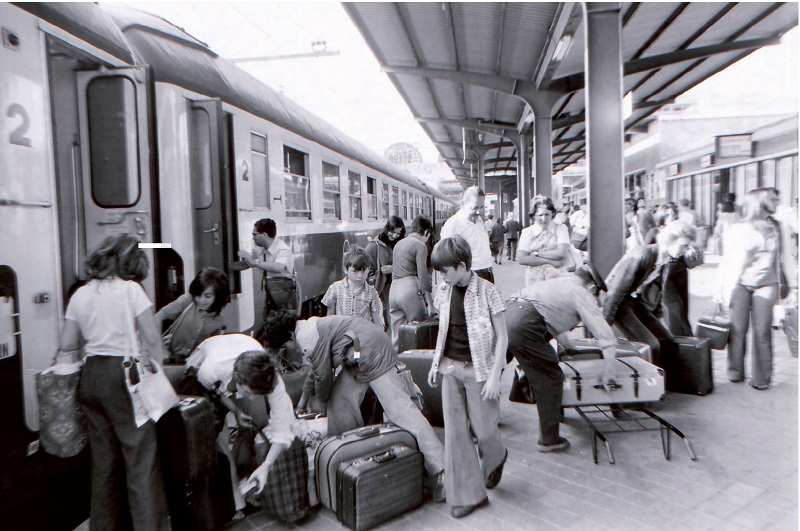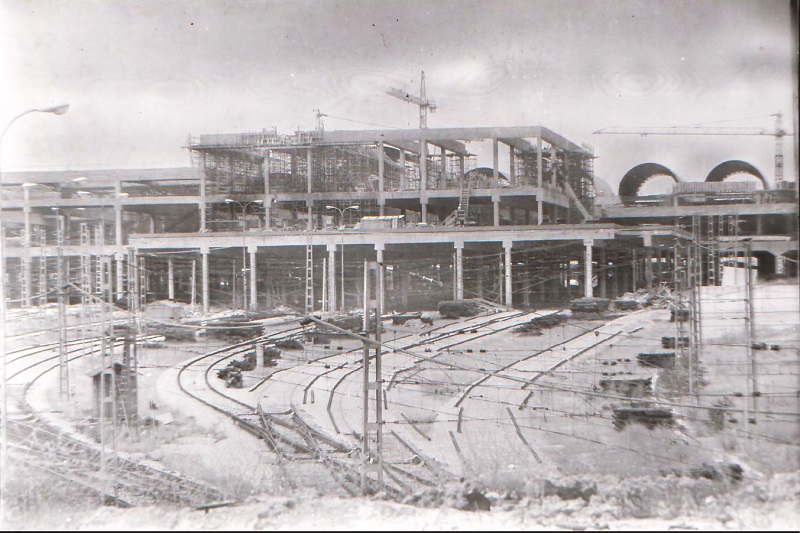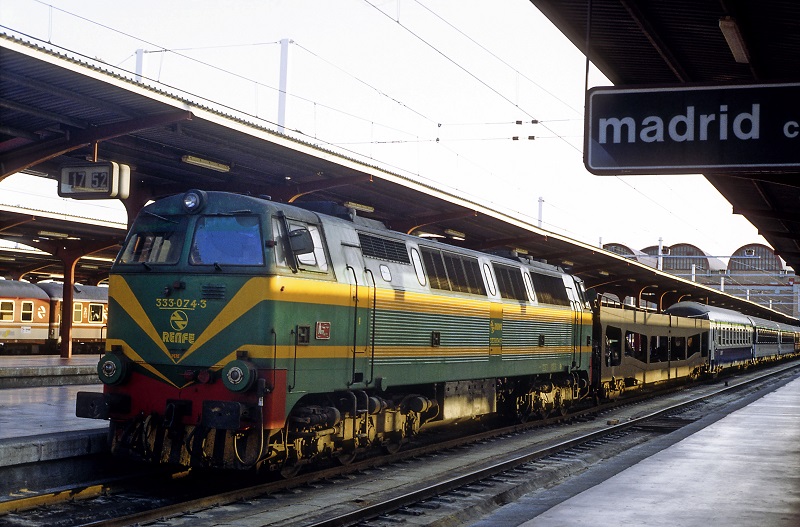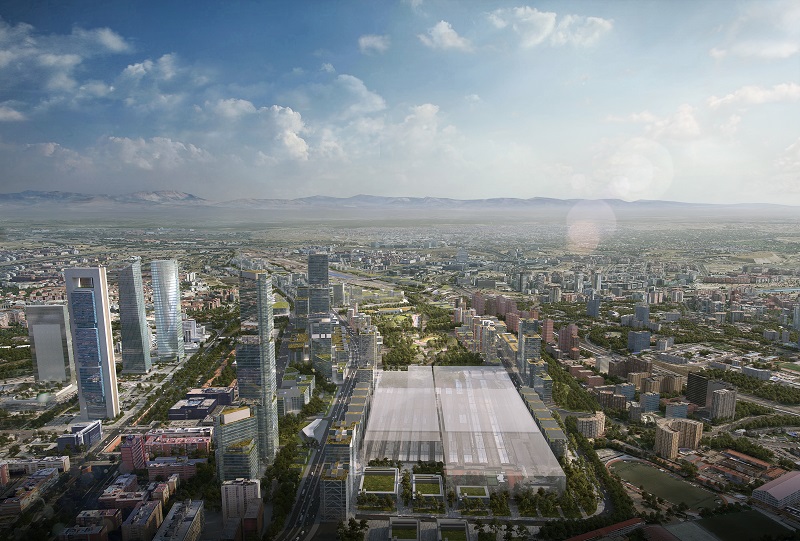29 April 2020
for Madrid Nuevo Norte


Photo: Regional Archive of the Community of Madrid, Martín Santos Yubero.
Following its 50 years of history, Chamartín Station is about to grow its service to 42 million travellers per year, becoming the AVE’s main hub. The international tender has been called to materialise this decisive transformation of the rail infrastructure that has connected Madrid’s residents for decades.
This station’s history dates back to the Second Republic when the Government decided to structure the city of Madrid and improve its rail connection to northern Spain, building a new train station in the town of Chamartín. It was only in 1967 when the project was realised with a new passenger terminal and one platform. Over the years, owing to Madrid’s growing rail needs, its capacity was expanded with a new station, reinventing itself while becoming a symbol of the city’s growth. Ironically, its rail tracks would limit Madrid’s urban growth to the north. Over half a century after, this situation is now going to be resolved thanks to Madrid Nuevo Norte.
En 1928, Madrid was about to reach the one million inhabitants milestone. It was decided that, given the growing communication infrastructure demands, a terminus would be built for the new railway line from Madrid to Burgos at the town of Chamartín de la Rosa. “It sought to ease the heavy traffic on the North Madrid-Ávila-Valladolid line”, explains Gonzalo Garcival, journalist, former editor-in-chief of the journal Vía Libre, of the Spanish Railway Foundation, and author of the book Estaciones de ferrocarril de España (Espasa-Calpe, 1995).
The earthworks for a temporary station began in 1933. However, the outbreak of the Spanish Civil War brought the project to a standstill during decades. The project gained meaning as a link between northern Madrid and Atocha station, in the south; a much-needed railway axis that would run through the city from end to end. The tunnel that would bridge the 7.3 km gap between Atocha and the new temporary Chamartín station would be finally completed in 1967. The facilities consisted of just a small building built parallel to the tracks. However, 175 commuter and long-distance trains were already operated from this station, and the Madrid-Burgos line was inaugurated in 1968.

Image of the Charmartín station construction works (1974). Photo: Regional Archive of the Community of Madrid, Martín Santos Yubero.
In 1972, the Government allocated nearly 2 billion pesetas for building the new Chamartín station. This significant investment was meant to cover the annual transportation needs of the 10 million travellers who use the long- and medium-distance services and 5 million commuters. The design also sought to meet the estimated growth requirements until 2000, namely 17.99 million commuters and 12.77 million long-distance passengers, as set out in the March 2019 edition of the journal Vía Libre.
The land used to develop the new infrastructure was near the original temporary station. The new facilities would cover an area of 127,000 square metres, including ancillary buildings and a covered 450-car parking. The project also envisaged a future link with the Madrid-Barajas airport, as well as the creation of a Postal Railway Transport Centre belonging to the Postal Service. The works began in 1970.
The station, as we know it today, opened in 1975. An infrastructure of primary importance, as it will link Madrid will the long-distance, railway network running through the north of Spain, and recently, with the High-Speed Rail system. Moreover, the station also had a second important role from the outset. It was meant to become Madrid’s central point for all communication. Gonzalo Garcival recalled that, with a view to making Chamartín the leading transport hub in Madrid, “the design also took into account its link with the Plaza Castilla-Fuencarral metro station and the future rail link with Barajas airport”.
The infrastructure represented an impressive breakthrough in mobility at the time. But what surprised the Madrid residents most “was that the station included a huge concourse with a shopping area and food court that went beyond newsstands and canteens”, said Garcival. Thus, Chamartín station became not only Madrid’s transportation hub but also a shopping and entertainment centre that even included a hotel.

The popular, non-stop “Puerta del Sol Express” departed from Chamartín to Paris. Photo 1992. Falk2
Based on the information provided by Renfe, 28 million travellers pass through Chamartín every year, and 1,120 trains serve the station daily. All regional commuter lines, except for the C5 and C9, operate from this station. This transport hub, which provides long- and medium-distance and commuter rail service, is frequently used by Madrid’s residents, more so as it is directly connected to the Metro lines 1 and 10 which operate from its homonymous metro station.
The call for international tender that took place in February 2020 has placed Chamartín station on the path to its definitive transformation to become Europe’s most advanced railway hub. During the tender presentation ceremony, the Minister of Transport, Mobility and Urban Agenda, José Luis Ábalos, stressed that “the new Chamartín station will be a shining example of a well-connected, European, sustainable station, that will bring people together and encourage coexistence in Madrid”.
This ambitious initiative, which will include 2 future terminus, 31 tracks and 16 platforms, will be fully integrated into the urban environment and will be linked to the new CBD at Madrid Nuevo Norte. It will also eliminate the gap created by the rail tracks that even today divide the northern districts in two. A strategic project that will drive the economy of the capital and the country, and fundamental for the transformation of Madrid in the coming decades thanks to Madrid Nuevo Norte.

The design of the future Chamartín station, at the heart of the Madrid Nuevo Norte project, will be chosen by an international tender that is currently ongoing.